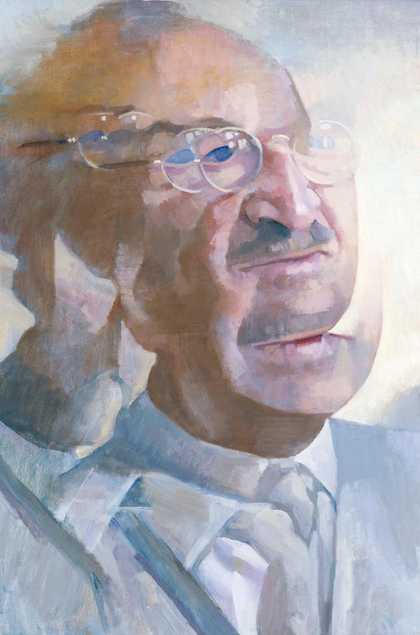
Fig.1
Sir Lawrence Gowing
Portrait of Sir Norman Reid 1980
Tate T03208
© The estate of Lawrence Gowing
By the time Norman Reid took over the directorship of the Tate Gallery from Sir John Rothenstein in 1964, he had already accrued considerable experience as a museum administrator (fig.1). Reid joined Tate in 1946 and within eight years had risen to become Deputy Director, a post he occupied until he was appointed Keeper in 1959. In these roles he was responsible for a series of operational initiatives, including establishing the gallery’s conservation department, setting up the Exhibitions and Education department, and founding the Friends of the Tate and the American Friends of the Tate. His unrivalled knowledge of the workings of the institution, the views of the trustees, and the financial constrictions under which the gallery operated made him a cautious but confident leader.1 During the fifteen years of his distinctive directorship he presided over the expansion of the gallery (the ‘North-East Quadrant’ opened in 1979) and the collection, especially in the area of early twentieth-century European art. Reid was also an active member of the Arts Council of Great Britain Art Panel from 1964 to 1974, a member of the Institute of Contemporary Arts Advisory Panel from 1965, and Chairman of the Fine Art Advisory Committee of the British Council between 1968 and 1975. Summarising these significant achievements, it could be said that Reid professionalised the administration of Tate and drew on his varied experience to ensure that the gallery was set up to accommodate the latest developments in art and the changing expectations of visitors.
When Reid took on the directorship of Tate, its dual remit – to collect both British art and international modern art – had not been reflected in the organisational structure of the institution. Early on, Reid created two keeperships to manage the sprawling collection, with Lawrence Gowing presiding over British art, and Ronald Alley appointed Keeper of Modern Art. As curator Martin Butlin explained in 2007:
[Reid] set about reforming the structure of the collections, and following this of the curatorial staff, which almost doubled. Hitherto the collection of British paintings of all periods, together with a few sculptures and drawings, had been regarded as one unit distinct from the collection of modern foreign art. Believing that the 20th-century holdings of the Tate could be much more fully integrated, Norman united them in the modern collection, bringing up the foreign paintings from the lower galleries, where they had been isolated, and showing them together with contemporary movements in British art.2
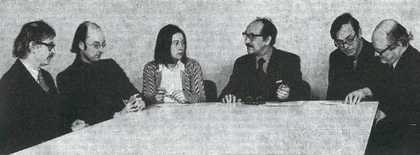
Fig.2
Left to right: Michael Compton, Richard Morphet, Anne Seymour, Sir Norman Reid, Ronald Alley and Martin Butlin
Reproduced in Studio International, vol.185, no.954, April 1973, p.181
The changes that Reid made to the way in which the collection was managed were enriched by the contributions of his new curatorial team, which by the mid-1960s included Martin Butlin, Michael Compton, Judith Jeffreys, Richard Morphet and Anne Seymour (fig.2). These individuals were professional curators, not the gentleman-scholars of the interwar years, and it is known that Reid highly valued their specialist expertise. His recollections of his time at Tate are captured in a series of recordings made between 2000 and 2005, and these tapes, as well as other documentary records, confirm that Reid looked to his staff to propose works for acquisition. Curators would identify and argue for the purchase of a work with Gowing or Alley, and then the two keepers would propose the acquisition to Reid, who would make the case with the trustees.3 In a recorded interview in April 2000 Reid remembered how he would sometimes ask Alley and Morphet, whom he described as ‘adventurous in [their] tastes’, to propose works directly to the trustees if they were particularly ‘enthusiastic’.4
In another interview recorded later in 2000 Reid recalled that Morphet advised him, ‘if you buy somebody buy the most extreme case’.5 However, Morphet remembers that Reid was often reluctant to buy ‘extreme’ cases, citing the purchase of Willem de Kooning’s The Visit 1966–7 (Tate T01108) in 1969 after overlooking works from the artist’s Women series of paintings, which had also been available. Reid probably stood with Ronald Alley’s observation that ‘buying … well in advance of public taste, is bound to lead to controversy from time to time’.6 The point to note here is that Reid’s advocacy was crucial to the acquisition process, and as Morphet confirms, despite occasionally being asked to propose works directly to the board, it was Reid who took ultimate responsibility for deciding which works should be considered by trustees.7
Throughout Reid’s directorship there were no more than ten members of the board – made up of civil servants, businessmen, academics, leading artists and cultural commentators – who each served a term of seven years, with second terms not unusual. Figures prominent in the arts included William Coldstream, Barbara Hepworth, Philip King, Henry Moore, Victor Pasmore, John Piper, Herbert Read and David Sylvester, while the chairmen were Sir Colin Anderson (1960–7), Anthony Lousada (1967–9), Sir Robert Sainsbury (1969–73) and Alan Bullock (1973–80).8
In the final years of his directorship Reid’s capacity to make significant purchases was aided by a shift in the British government’s attitude towards the arts: the grant for acquisitions was increased from £40,000 to £60,000 (rising to £1,570,000 in 1979–80), with an additional £50,000 to buy twentieth-century ‘classics’.9 With this increase in public funding Reid presided over a number of initiatives that greatly expanded and enhanced the collection of European and British art, but early on in his directorship Reid also articulated the aspiration to ‘have the best representation of American painting outside the United States’.10 Indeed, the minutes of Tate meetings record a continual ambition for the collection of American works to grow into one that was both ‘representative’ and ‘vital’.11
Attitudes to American modernism
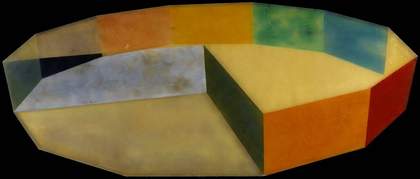
Fig.3
Ron Davis
Vector 1968
Tate T01068
© Ron Davis
Ronald Alley’s 1959 catalogue of Tate’s ‘foreign paintings, drawings and sculpture’ attests to the narrowness of the American art collection at the start of Reid’s tenure.12 The earliest work listed is an Augustus Saint-Gaudens bronze relief of Robert Louis Stevenson from c.1887–92, while other notable works included Downtown, New York 1923 by John Marin (Tate T00080) and Yellow Sky 1958 by Milton Avery (Tate T00575). Ten years later, however, work by the likes of Louise Nevelson, John Chamberlin, Ron Davis, Isamu Noguchi, David Smith, Robert Morris, Alexander Calder, Charles Biederman and Tony Delap were celebrated in another book authored by Alley, this time devoted exclusively to recent American art acquired by Tate.13 Yet despite the clear expansion of the collection represented by this list of names, Reid, in his foreword to the book, still felt the need to identify ‘notable omissions’, stating that ‘Tate badly needs, among other things, works by Gorky, Still, Reinhardt, Gottlieb, Motherwell, Rauschenberg and Oldenburg’.14 This list of names confirms the centrality of New York School painting in the gallery’s assessment of American art, although Alley himself noted how ‘much interesting work is now being produced in the Los Angeles area’.15 Alley referred in this regard to Tate’s purchase of Vector 1968 (Tate T01068), a work by West Coast artist Ron Davis (fig.3). Tate had also acquired two paintings by Californian-born Sam Francis by 1964, including Around the Blues 1957, c.1962–3 (Tate T00634).16 As far as possible, Reid and his curators seemed to have recommended works for purchase that redressed ‘notable omissions’.
It is useful to note here that Reid was also a practising artist and, although he was characteristically modest about his own work, demurring that he ‘never broke new ground’, he believed that his practical knowledge of art gave him a unique perspective as a museum official.17 According to Morphet, in an interview of 2017, Reid’s criterion for something entering the collection was that ‘it had to show evidence of stylistic advance’.18 His personal tastes, however, did not always dispose him towards works that were extreme and challenging in nature. In this respect Reid’s resistance to ‘qualities in works of art’ such as ‘intensity of content and reflection of raw human experience’, led him to overlook objects that were ‘highly distinctive in themselves’ but did not appear to Reid to ‘show evidence of stylistic advance’. Morphet pointed to the absence of paintings by Edward Hopper, Frida Kahlo and Marsden Hartley as grave instances of Tate’s, and Reid’s, blind spots.19 Furthermore, Reid was, privately, not kindly disposed towards pop art, later remembering that it fell ‘outside his sympathies’.20 In these respects, the interests of the director and the curators failed to converge. Tate under Reid was not wholly receptive to the varied critical idioms in which the creative energy of modernism revealed itself, and according to some, it was only because Alley exceeded his position as Reid’s adjunct that Tate’s collection was able to grow internationally during this period.21
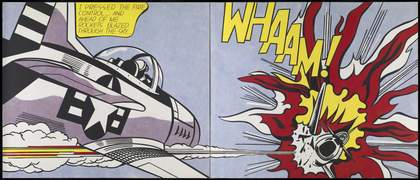
Fig.4
Roy Lichtenstein
Whaam! 1963
Tate T00897
© Estate of Roy Lichtenstein
It was not only Reid but, even more critically, the trustees who needed convincing about the merits of certain works of modern American art. It is no secret that the acquisition of Roy Lichtenstein’s Whaam! 1963 (fig.4) in 1966 was hotly debated by the board and aroused, as Reid observed, more public interest than any other acquisition since the Second World War.22 Morphet, who had only recently been appointed to Tate’s curatorial team, was asked by Reid to make a written case for the purchase in June 1966. The painting was being offered by the Sonnabend Gallery in Paris, the premiere showcase for American pop art in Europe and, moreover, the partner gallery to Lichtenstein’s New York dealership, the Leo Castelli Gallery. Morphet was excited by the prospect of the purchase but Reid knew it would be difficult to persuade the trustees to buy it, notwithstanding the price reduction offered by Ileana Sonnabend. For their part, the trustees were divided on the merits of the work, with the art historian and critic Herbert Read, along with artists Andrew Forge and Barbara Hepworth, vehemently opposed to its acquisition. Read, who joined the board in 1965, had been a leading commentator on modern culture since the early 1930s and favoured a humanistic version of modernism rooted in the critical authority of the aesthetic imagination. He dismissed Whaam! as nothing more than ‘nonsense’.23 Forge, who like Read was sympathetic to contemporary forms of painting arising from the tradition of modernist figuration, warned ‘that it might be wrong for the Tate to allow itself to become a platform for the newest of the new’. The minutes of the board meeting continue:
He [Forge] was not sure that it would be right to show the Lichtenstein exhibition, and was sorry that the Gallery was to accommodate the Young Contemporaries Exhibition. He believed that the Board should observe more rigorously the implications of the fact that the Tate was a museum with a responsibility to present values that had been established through the years. Other Trustees expressed a different view and it was pointed out that exhibitions of controversial art in the context of the museum were often an invaluable test of its standing. If avant-garde exhibitions were to be consigned automatically to specialist and outlying galleries, the effect would merely be to perpetuate a separation which many regarded as undesirable and deprive a modern museum of its source of vitality and information which many corresponding centres abroad regarded as indispensable.24
This debate reflected a commonly heard criticism of avant-gardism as nothing more than cooked-up shocks and manufactured dissent. Morphet, ever resourceful, countered this view by arguing in a briefing paper that Whaam! constituted ‘one of this century’s most far-reaching extensions of the territory available for serious aesthetic exploration’. Morphet’s defence of the painting swung the debate, for it was immediately acquired and became one of the gallery’s most recognisable artworks.
Visits to the United States
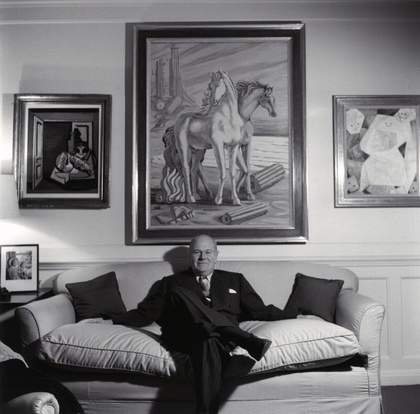
Fig.5
Ida Kar
Sir Robert Philip Wyndham Adeane 1959
National Portrait Gallery, London
© National Portrait Gallery
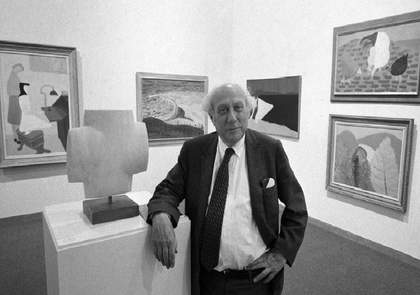
Fig.6
Roy R. Neuberger amid his collection at the Neuberger Museum of Art, State University campus, Purchase, New York, 1974
Photo © Michael Evans/The New York Times
One of Reid’s most important jobs as director was to court potential donors and solicit gifts from artists on his trips to New York, making use of his network of friends and influential acquaintances. Reid knew the collector Peggy Guggenheim and stayed with her in Venice almost every year while he was director of Tate.25 He also forged connections through the aristocratic businessman and art collector Sir Robert Adeane (fig.5), who financed his first visit to New York in the mid-1960s, with the pair travelling together on the RMS Queen Mary and staying in upmarket hotels in Manhattan. Thereafter, Reid went to New York every year of his directorship and came to know all the main dealers in the area. On these visits Reid became great friends with the American financier Roy Rothschild Neuberger (fig.6), and it was through Neuberger that Tate started to collect artworks gifted via the American Federation of the Arts.26 This unique arrangement with the UK – which allowed American artists to receive tax relief, sometimes amounting to more than the sums originally paid for the work – garnered the interest of a number of artists who saw the kudos attached to being in the premiere public art collection in London.27
In an interview in 2005 Reid described how ‘we [he and his wife Jean] had become professional beggars’ on their visits to America.28 The immediate fruits of their labours were evident in the ‘Director’s Report’ of 1968–70: of the 144 works acquired for the collection during this period over half were received as gifts with a further thirty-four purchased from trust funds set up by gifts or bequests. These included a sculpture by Naum Gabo and paintings by de Kooning, Robert Motherwell, Gene Davis, Ad Reinhart and Barnett Newman.29 Reinhardt also promised Reid two paintings through the scheme with the American Federation of the Arts, including a large canvas painted with orange and red, although his premature death in 1967 meant the gift was never formalised.
Of all the gifts brokered by Reid, two exceptional cases vastly enriched Tate’s collection of American art. One was the remarkable gift by Naum Gabo of over 50,000 items including photographs, prints, drawings and sketchbooks from his private collection, which was secured in 1977.30 Gabo, born in Russia, was domiciled in the United States from 1946 and became a US citizen in 1952. Reid and his wife Jean were regular guests at the Gabos’ Connecticut home throughout the 1960s and 1970s and when the gift was formalised Reid remarked that ‘Gifts such as these give the collection its unique character and particular richness’.31 The other remarkable gift, made earlier in 1970, was of the so-called Seagram Murals, a group of nine large paintings by Mark Rothko, whose extensive negotiations with Reid over their acquisition by Tate require a more detailed account.
The Seagram Murals
Reid had negotiated the purchase of Rothko’s Light Red Over Black 1957 (Tate T00275) during Rothenstein’s directorship and by the time he became director himself had established friendly terms with the painter. Rothko was uncharacteristically ‘warm and charming’ towards the affable and unassuming Reid, who later recalled their shared love of painting and whisky, forged over several visits to the artist’s New York studio, dating from 1965.32 These visits were intended to nurture the idea of Rothko donating works of his to the Tate Gallery, and, according to Reid, the artist ‘responded warmly to the possibility of his work being in the same building as Turner’s paintings’.33 Reid and Rothko had together attended the touring show Turner: Imagination and Reality, co-curated by Lawrence Gowing and the Museum of Modern Art’s Monroe Wheeler, held at MoMA in New York in 1966. In curating the show, Gowing and Wheeler aimed to demonstrate the ‘kinship’ between Turner and abstract art, and it is known that Rothko himself returned to the exhibition many times, deepening his sense of affiliation with the nineteenth-century British artist.34
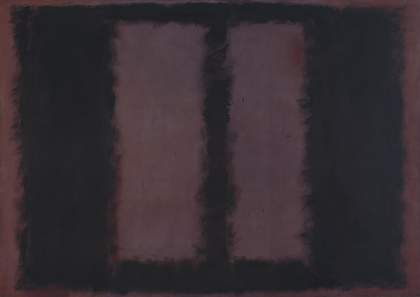
Fig.7
Mark Rothko
Black on Maroon 1958
Tate T01031
© Kate Rothko Prizel and Christopher Rothko/DACS 2019
Lured by Reid’s companionable attentions, and hooked by the prospect of being represented alongside the premiere collection of paintings by Turner, Rothko was primed to make a significant donation to Tate. Begun in 1958, the Seagram Murals were originally intended for the upmarket Four Seasons restaurant in the Seagram Building in New York, a landmark Park Avenue skyscraper designed by Mies van der Rohe and Philip Johnson. For a host of reasons Rothko reneged on the commission and Reid approached the painter with a view to acquiring the paintings. The first of the nine, Black on Maroon 1958 (fig.7) was gifted through the American Federation of Arts in 1968, and in choosing to donate the remaining paintings to Tate Rothko was undoubtedly reassured by Reid’s plans for the murals.
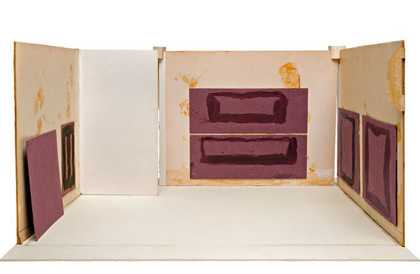
Fig.8
Maquette for the installation of Rothko’s Seagram murals at the Tate Gallery
Tate Archive Photographic Collection
© Kate Rothko Prizel and Christopher Rothko / DACS 2019
Photo © Tate
Rothko was famously insecure in his dealings with patrons and Reid was required to manage his expectations closely. For example, Rothko was worried that his work might be unappreciated in Britain and fretted to Reid that it may ‘be consigned to the basement’.35 Rothko was also concerned about how the paintings would be physically installed at the gallery. In 1969 Reid created a cardboard maquette, at Rothko’s request, to visualise the installation of what would become known as the Rothko Room (fig.8). The artist’s curatorial directions were stringent and Reid was also given colour patches for the maquette. Rothko was insistent that the walls should be painted ‘a grey inclining to warmth, as otherwise the pictures, being mostly crimson/black, tend to make a neutral grey look green’.36 At first Reid and Rothko planned to install the paintings in Room 18, a space shared with works by the Swiss sculptor Alberto Giacometti. However, the planning of the installation went through several permutations before Rothko was happy.37
Reid’s transaction with Rothko was an inadequate salve to the artist’s mounting depression. The last time Reid met with Rothko he found him in ‘a touch and go state’.38 The Seagram Murals arrived at Tate on the day Rothko took his life in New York in 1970. In the event, Tate created a dedicated room for the paintings at Millbank. Although there was no stipulation that all nine works needed to be hung together, Tate has always endeavoured to do this, albeit in different venues.39
Exhibitions of American Art
By the late 1960s the Tate Galley had come to recognise the central importance of contemporary American art, a point tacitly acknowledged by Reid in his foreword to Alley’s 1969 book Recent American Art, in which he announced his ambition for the Tate to have ‘the best representation of American painting outside the United States’. Alley’s introduction to the book laid out the grounds on which Tate understood and presented the American collection during the late 1960s, offering a narrative of ‘struggle’, ‘experimentation’ and ‘radical breaks with tradition ... from more orthodox styles’.40
However, it was not only through acquiring works for the collection that Tate engaged with American art. Indeed, it was Reid who believed most strongly that Tate should become known as a leading exhibition venue. In a statement published in Studio International in 1971 he explained that ‘no museum of modern art can perform its full function through its permanent collection alone; however rich the collections, the temporary exhibitions which are shown beside it add an entirely new dimension’.41 It must be stressed, however, that Tate was just one venue among others in London striving to showcase new art; under Bryan Robertson, the Whitechapel Art Gallery became the capital’s premiere place to see solo exhibitions by American artists, and, under Lawrence Alloway, the Institute of Contemporary Arts (ICA) established a reputation for presenting the most innovative contemporary art.42 Tate had to find a distinctive identity for its exhibitions. The minutes of a board meeting held in October 1966 record Reid’s statement to the trustees that the Arts Council’s ‘somewhat avuncular’ relationship to Tate meant that it was ‘insufficiently aware’ of how important it was for the gallery to have a leading role in the exhibition field.43 A few months later, at another board meeting, he articulated the view that Tate should take a braver position in relation to debates around contemporary art:
The Tate is amongst other things, a museum of contemporary art, it is essential that it should be actively committed to contemporary art and therefore put on exhibitions of quite young artists, of comparatively recent movements, or even of technical developments, whenever we are convinced that they are in some way decisive to the development of painting and sculpture, but only then … Our public is a young one whose memory does not go back many years; there will soon be several largish galleries in London putting on exhibitions in our field. All these things argue that we should only attempt to do what is appropriate to the Tate Gallery and even then select only the most vital.44
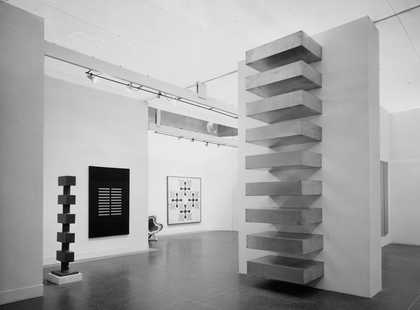
Fig.9
Installation view of The Art of the Real, Tate Gallery, 1969, with works by Donald Judd, David Smith, Agnes Martin and Paul Feeley
© Donald Judd Foundation/VAGA, New York and DACS, London 2019
© Estate of David Smith/DACS, London/VAGA, New York 2019
© Estate of Agnes Martin
© Paul Feeley
In response, the board accepted that ‘topical and even contentious exhibitions might well be mounted at the Tate from time to time. To leave them entirely to other organisations was to sacrifice an essential part of the function of the museum of modern art’.45 This kind of support ensured that Reid’s curators could devise an ambitious programme of exhibitions, with four or five shows being presented each year of Reid’s directorship, although few of them were devoted to American art. In 1966 David Smith was the first American artist to get a solo exhibition at the Tate, while 1968 saw two in quick succession, the first devoted to Roy Lichtenstein and the second to Willem de Kooning, the latter organised by MoMA.46 A year later another MoMA touring exhibition arrived, this time a group show called The Art of the Real: An Aspect of American Painting and Sculpture 1948–1968 (fig.9), which had been dogged by controversy during its European tour. Bearing in mind that this was 1969, when anti-Vietnam War demonstrations were taking place outside the American Embassy in London, Tate did surprisingly little to prepare for the hostility that met the show and its precepts. The exhibition – which included work by Ellsworth Kelly, Ad Reinhardt and Barnett Newman – was derided by some as a piece of Cold War propaganda that promoted the idea of American freedom against the totalitarian regimes of communist states.47 Critics pointed out that the show also failed to acknowledge the European precedents for some of the work, and claimed that much on view was elitist and impenetrable.48 Eugene Goossen, the exhibition director, was pilloried for imagining that American artists had somehow invented minimalism in isolation from developments in Europe, while Tate was charged with promoting what seemed to be an insular form of art (what Goossen called ‘autonomous’) that had no social purpose or power to elevate the viewer.49 Goossen argued that, ‘Today's “real” … makes no direct appeal to the emotions, nor is it involved in uplift. Indeed, it seems to have no desire at all to justify itself, but instead offers itself for whatever its uniqueness is worth— in the form of the simple, irreducible, irrefutable object’.50
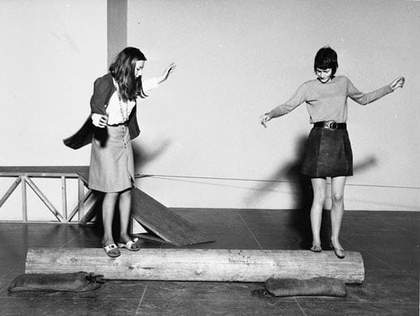
Fig.10
Visitors engaging with works in the Robert Morris exhibition at the Tate Gallery, 1971
Tate Archive Photographic Collection: Robert Morris 1971
Despite this show’s poor reception, the Tate Gallery continued to stage exhibitions devoted to American art, with a group show for Larry Bell, Robert Irwin and Doug Wheeler appearing in 1970, then solo shows for Andy Warhol and Robert Morris the following year. Of all the exhibitions of American art to take place while Reid was director, it was the Morris show that generated the most bemusement from the press. Invited by Tate to put together a large-scale presentation of his work, Morris decided against preparing a retrospective and elected instead to create a new body of work described as ‘participatory objects’.51 In his pitch to the exhibition’s organiser, Michael Compton, Morris quipped: ‘the show is more environmental than object-like, offers more the possibility – or even necessity – of physically moving over, in, around, rather than detached viewing. Personally, I’d rather break my arm falling off a platform than spend an hour in detached contemplation of a Matisse’.52 Visitors would be invited to interact playfully with a set of wooden and metal structures, which could be climbed on, walked over or crawled through (fig.10).53 The critic Reyner Banham, who attended the press preview, remarked in the New York Times: ‘the place was a bedlam in which all rules of decorum had been abandoned as liberated aesthetes leaped and teetered and heaved and clambered and shouted and joined hands with total strangers’.54 Other critics termed it an ‘Army assault course’, an ‘adventure playground’, ‘funfair art’ and ‘a gymnasium, only simpler’.55 After the first week headlines escalated and the Daily Express coined it a ‘five-day orgy of destruction’.56
In some ways the exhibition could be said to have countered the criticisms levelled at The Art of the Real, that the ‘irrefutable objects’ of minimalist artists were remote and incapable of uplifting viewers. Morris’s art was presented as a model of engagement, as ‘an art that goes beyond making, selling, collecting and looking-at kind of art, and proposes a new role for the artist in relation to society’.57 The exhibition was meant to run from 28 April to 6 June 1971 but during the first week sixteen people were injured (some by falling off a log), and Reid had no choice but to close the exhibition on health and safety grounds, issuing a public statement that some visitors had become ‘unexpectedly boisterous … exuberant and excited in their participation’.58 This was very revealing: Reid’s ideal standpoint was to stand above conflict, but not to pass judgement on it.59
The ‘bricks’
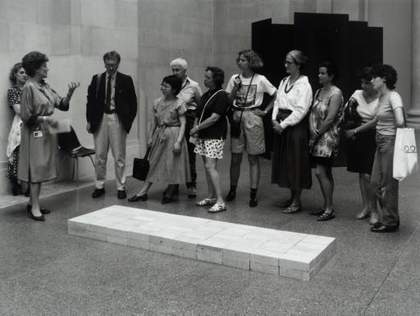
Fig.11
Carl Andre’s Equivalent VIII 1966 installed at Tate Gallery, 1976
Tate T01534
© Carl Andre/VAGA, New York and DACS, London 2019
Reid’s somewhat fraught encounters with American minimalism, inaugurated by The Art of the Real in 1969, were further complicated by the gallery’s purchase of a sculpture by Carl Andre in 1972 (fig.11). The work, consisting of 120 ready-made fire bricks arranged in a rectangle, was known at the time simply as Untitled, although it subsequently became known as Equivalent VIII for it originally formed part of a larger installation of eight similar brick structures.60 Although the purchase was secured in 1972, it was not until 1976, two years after the publication of Tate’s biennial report, that the acquisition was picked up by journalists. The 1974 report included ‘A Note on Conceptual Art’ by Richard Morphet, which sought to prepare audiences for the acquisition of conceptual and minimalist art by acknowledging that this kind of work (Morphet listed ‘video, sound cassettes, colour slides, photographs, maps, texts, diagrams and lines drawn directly on the gallery walls’) might challenge visitors’ expectations, arguing that conceptualism opened up ‘acts, facts, people, objects, situations … to a creative scrutiny that revitalises art and enriches life’.61
Before discussing the heated reception of Andre’s sculpture, it is worth outlining the cultural and economic context in which the acquisition was made. The minutes of a Tate board meeting from November 1970 reveal that the gallery was concerned about the rising cost of art offered by New York dealers, and particularly of minimalist and conceptual art. A note in the minutes titled ‘American Prices’ records that Reid had been investigating the high prices of American works on a recent visit to New York:
It seemed clear to him that American works were overpriced in America and also by comparison with other schools ... American dealers and collectors seemed determined to maintain the high level of prices of any works which were available at public sales. In private sales he understood that the prices were widely negotiable. He felt that the Gallery must be wary of paying the high asking prices and should in general make an offer, it had been suggested for as little as a quarter of the price, leaving the dealer to find the rest by means of tax arrangements. The flexibility of prices had been illustrated in his discussion about Judd with Leo Castelli who, without hesitation, had offered to make a work available at $10,000 (half the asking price). The Director had not pursued this offer as he hoped it might be possible to obtain a Judd by gift. In the light of the amount of the purchasing grant and the Tate’s wide responsibilities for other schools he hoped that the close grip which American dealers had on the market could be circumvented by deliberately seeking out particular works from individual collectors.62
Reid was well aware of the problems that collecting conceptual art posed for Tate. The minutes of a meeting in 1973 acknowledged that his staff had ‘given a great deal of thought to this area of art about which it was admittedly difficult for even such a body as the Trustees to be fully informed’.63 Reid told the Board that he ‘thought the time had come to try to review this field of activity as completely as possible and to decide how widely the various kinds of work were to be represented in the collection’. Reid tasked the staff of the Modern Collection with drawing up a list of works which they ‘regarded as import and available’.64 Reid went so far as to establish an Ad-Hoc Conceptual Art Sub-Committee to consider the recommendations. With Grant-in-Aid funds the trustees agreed to purchase works by Joseph Beuys, Victor Burgin, Jan Dibbets, Dan Graham, John Hilliard, Sol LeWitt, Richard Long, Bruce McLean, Klaus Rinke and David Tremlett.65
The 1974 report that noted the acquisition of the Andre sculpture was picked up by Colin Simpson, a journalist writing for the ‘Business News’ section of the Sunday Times, who singled out the untitled work for especial censure. Simpson portrayed Andre as an impudent agent of chaos, who had duped Tate into paying ‘a price tag of $12,000 dollars’, and contested the monetary value of this ‘insouciant masterpiece’.66 Following the publication of the article several more newspapers picked up the story, which spiralled into a scandal that haunted the remaining years of Reid’s directorship, and the Tate Gallery more generally. It is not the place of this essay to itemise the barrage of hostile press that was directed at Tate and Reid, but headlines such as the Daily Mirror’s ‘What a Load of Rubbish’, summed up the prevailing mood.67
Beyond the tabloid notices, Reid also had to confront the outrage of the art press. The Burlington Magazine waded into the debate with a damning editorial in April 1976 questioning Tate’s decision to buy the work.68 Reid immediately resigned from his position on the magazine’s board, and asked Morphet, then Deputy Keeper of the Modern Collection, to prepare a response. Morphet’s article, published in the November issue of the Burlington Magazine, retorted: ‘the Gallery considers its main task to be the acquisition of a range of work sufficient to demonstrate, through examples of high quality, those distinctive tendencies favoured by the Director and Trustees in the periods for which the Tate has responsibility, including the present’.69 Morphet’s retort has all the critical deftness of its author, particularly in the articulation of the value of conceptual art, but it also resounds with Reid’s belief in Tate as a repository for quality examples of progressive art.
By 1977 Reid and his curators were thinking about how to display Equivalent VIII and decided that context was key to gaining public approval. They placed the work together with about a dozen other pieces of minimal art in Gallery 19.70 The minutes of a board meeting show that the Publications Department had also been tasked with publishing a forty-eight page booklet, putting the work in context:
the intention was to provide a wider circulation for the argument set out in Mr. Morphet’s article published in ‘The Burlington Magazine’ … The Chairman was perfectly happy for this to be done but he was greatly concerned by the preceding generous selection of cartoons and hostile press comments. He felt that by amassing the anti-Tate material in this way it further promoted antagonism and gave very little chance for the serious article to be read sympathetically. Lord Harlech and Mr. Graham-Harrison both enquired what audience the booklet was aiming at since Mr Morphet’s article was not one which ordinary visitors to Tate would be likely to find easy reading. After further discussion the Trustees decided that the booklet required careful reconsideration and they asked to see the booklet again if it was decided to proceed with it.71
Reid regarded Andre’s work as an ‘anchorage’ in the development of modern art. He described how he ‘felt tuned into’ the formal aspect of Equivalent VIII, remarking on how it fell ‘within the scope of [his] own responses’.72 Perhaps it was for this reason that Reid took it upon himself to be the Tate’s press spokesperson on the matter, ‘muzzling’ his curators, as Richard Morphet remembered, despite being ill-prepared to face the barrage of questions – particularly about the undisclosed price of the piece.73
Sympathetic friendships
Reid’s personal tastes in art, as Morphet recalls, were for the work artists such as Robyn Denny, Naum Gabo, Barbara Hepworth, Ben Nicholson and Mark Rothko. He was drawn to works that were, in Morphet’s phrase, ‘not extreme or full-blooded’, meaning that Reid preferred order and restraint to expressionist work.74 Simon Wilson, former Curator of Interpretation at Tate, recalled that Reid ‘dragged Tate into the twentieth century’ but, referring to the Andre acquisition, added ‘I don’t think he really believed in the Bricks’.75
Wilson’s separation of Reid’s professional achievement and personal taste is telling. On the hand, Reid was the force of organisational change, pulling Tate into a new phase of its history, but on the other, Reid may not have been entirely convinced by some of the art that this project involved. There were certainly works purchased or acquired by Tate that fell outside of Reid’s tastes, but to what extent was Tate’s collection inhibited by Reid’s ‘disbelief’ in certain works of art? As we have seen, Reid set out with the hope, expressed in 1967, to ‘have the best representation of American painting outside the United States’.76 The three-fold increase in the size of the American collection under Reid’s leadership certainly testifies to the strength of this ambition, while the names of artists whose work was acquired for the first time under Reid perhaps provide a better measure of quality. By 1981 Tate could boast strong holdings in post-war American art, with fine examples of works by abstract expressionist painters (Guston, Kline, de Kooning, Motherwell, Newman, Pollock, Reinhardt, Still and others), pop artists (Johns, Lichtenstein, Oldenburg, Rauschenberg, Rosenquist and Warhol) and minimal and conceptual artists (including Andre, Huebler, LeWitt, Judd, Morris and Stella). However, one could also draw up a long list of prominent American artists overlooked during Reid’s directorship, such as Jacob Lawrence and Ed Ruscha. And the gallery was certainly slow and cautious in its uptake of pop art in comparison to certain European institutions, such as the Moderna Museet in Stockholm led by Pontus Hultén, and in contrast to the exhibition programmes of the ICA and Whitechapel Gallery in London.
It could be said that one of Reid’s many achievements was to find a way of balancing his own unsystematic intuitions about the nature of modern art with the professional-administrative need to classify and organise the Tate collection. We detect some understanding of the delicacies involved in this from the valedictory announcement of the Board of Trustees upon his retirement in 1979:
It is with sadness that we report Sir Norman Reid’s retirement … Yet there is much pleasure in looking back at his long and distinguished association with the Gallery since 1946 … During his directorship from 1964 the Gallery, with the enrichment of the collections and the spectacular growth in its activities has become firmly established as a major institution of international stature … Nor may we forget the splendid gifts which the Gallery has received through his sympathetic friendships with artists – Mark Rothko, Naum Gabo [and others] … have presented groups of works which the Gallery has every reason to be proud – and the many benefactors who have donated works either directly or through the Friends of the Tate Gallery of which he was a founder member.77
The key reference points here, which knit together different elements of the statement, are ‘association’ and ‘sympathetic’. It is implied that Reid presided over a place of friendship. Key to this were his close contacts with American artists, and his creation of a body of wellwishers, the Friends of the Tate Gallery. Here, as in other contexts, Reid had been able to assert personal charm and social authority without the need to demonstrate intellectual or art historical insight. This is not to deny that he appreciated the nature of occupational skills, as practiced by his team of curators at the Tate. Nonetheless, it was the continuity of culture as expressed in the warmth of shared human experiences that mattered to him, and which shaped the collection of American art during his directorship.
